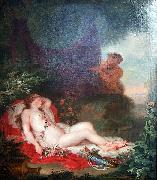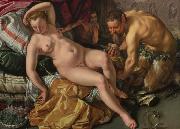Wholesale Oil Painting No Minimum |
|||||||||||
|
|
|||||||||||

|
|||||||||||
|
|
|
||||||||
anna dorothea therbusch1721-82 German painter of Polish descent. She was taught by her father, the portrait painter Georg Lisiewski (1674-1751), and received further training from Antoine Pesne in Paris. She worked for Charles-Eugene, Count of W?rttemberg, in Stuttgart from 1761 to 1762, and for Charles Theodore Wittelsbach, Elector Palatine of the Rhine, in Mannheim from 1763 to 1764. In 1765 she returned, via Stuttgart and Hohenzollern-Hechingen, to Paris, where in 1767 she became a member of the Academie Royale. She met Denis Diderot and Philipp Hackert, both of whom she painted, and Charles-Nicolas Cochin , but, despite consistent support from Prince Galitsyn, she was unable to establish herself in Paris. In 1769 she returned to Berlin where she received commissions for mythological paintings (e.g. Diana and her Nymphs, 1771; Potsdam, Neues Pal.) from Frederick II, King of Prussia. She painted portraits of members of the Prussian court, and the Berlin bourgeoisie, and in 1773 was commissioned by Catherine II, Empress of Russia, to paint a portrait of the Prussian royal family. |
||||||||
|
|
||||||||
Jupiter und Antiope
Jupiter und Antiope Painting ID:: 68660 |
Jupiter und Antiope, von Anna Dorothea Therbusch, 1775. Jupiter nähert sich in Gestalt eines Satyrs Antiope, Tochter des Nykteus, Königs von Theben. Die schlummernde Schönheit ahnt noch nichts von dem bevorstehenden gewaltsamen Akt und dem daraus resultierenden tragischen Schicksal. - Ausgestellt in Schloss Friedrichsfelde (Standort des Stadtmuseums Berlin) Jupiter und Antiope, von Anna Dorothea Therbusch, 1775. Jupiter nähert sich in Gestalt eines Satyrs Antiope, Tochter des Nykteus, Königs von Theben. Die schlummernde Schönheit ahnt noch nichts von dem bevorstehenden gewaltsamen Akt und dem daraus resultierenden tragischen Schicksal. - Ausgestellt in Schloss Friedrichsfelde (Standort des Stadtmuseums Berlin) |
|||||||
|
|
||||||||
Hendrick Goltzius1558-1617 Dutch Hendrik Goltzius (1558 - January 1, 1617), Dutch printmaker, draftsman, and painter, was born at Millebrecht, in the duchy of Julich. He was the leading Dutch engraver of the early Baroque period, noted for his sophisticated technique. After studying painting on glass for some years under his father, he was taught the use of the burin by Dirk Volkertszoon Coornhert, a Dutch engraver of mediocre attainment, whom he soon surpassed, but who retained his services for his own advantage. He was also employed by Philip Galle to engrave a set of prints of the history of Lucretia. At the age of 21 he married a widow somewhat advanced in years, whose money enabled him to establish at Haarlem an independent business; but his unpleasant relations with her so affected his health that he found it advisable in 1590 to make a tour through Germany to Italy, where he acquired an intense admiration for the works of Michelangelo, which led him to emulate that master in the grotesqueness and extravagance of his designs. He returned to Haarlem considerably improved in health, and laboured there at his art till his death. Goltzius' painting Lot and his daughters (Rijksmuseum Amsterdam) shows Lot being seduced by his two daughters. Sodom and Gomorrah are shown burning in the background, with Lot's wife who had turned into a pillar of salt, in front.Goltzius ought not to be judged chiefly by the works he valued most, his eccentric imitations of Michelangelo. His portraits, though mostly miniatures, are masterpieces of their kind, both on account of their exquisite finish, and as fine studies of individual character. Of his larger heads, the life-size portrait of himself is probably the most striking example. His masterpieces, so called from their being attempts to imitate the style of the old masters, have perhaps been overpraised. Goltzius brought to an unprecedented level the use of the "swelling line", where the burin is manipulated to make lines thicker or thinner to create a tonal effect from a distance. He also was a pioneer of "dot and lozenge" technique, where dots are placed in the middle of lozenge shaped spaces created by cross-hatching to further refine tonal shading. A self portraitHollstein credits 388 prints to him, with a further 574 by other printmakers after his designs. In his command of the burin Goltzius is said to rival that of Durer's; but his technical skill is not equally aided by higher artistic qualities. Even, however, his eccentricities and extravagances are greatly counterbalanced by the beauty and freedom of his execution. He made engravings of Bartholomeus Spranger's paintings, thus increasing the fame of the latter - and his own. Goltzius began painting at the age of forty-two; some of his paintings can be found in the imperial collection at Vienna. He also executed a few chiaroscuro woodcuts. He was the stepfather of engraver Jacob Matham. |
||||||||
|
|
||||||||
|
|
Jupiter und Antiope
Jupiter und Antiope Painting ID:: 81508 |
Date 1612
cyf Date 1612 cyf |
||||||
|
|
||||||||
|
Hendrick Goltzius 1558-1617 Dutch Hendrik Goltzius (1558 - January 1, 1617), Dutch printmaker, draftsman, and painter, was born at Millebrecht, in the duchy of Julich. He was the leading Dutch engraver of the early Baroque period, noted for his sophisticated technique. After studying painting on glass for some years under his father, he was taught the use of the burin by Dirk Volkertszoon Coornhert, a Dutch engraver of mediocre attainment, whom he soon surpassed, but who retained his services for his own advantage. He was also employed by Philip Galle to engrave a set of prints of the history of Lucretia. At the age of 21 he married a widow somewhat advanced in years, whose money enabled him to establish at Haarlem an independent business; but his unpleasant relations with her so affected his health that he found it advisable in 1590 to make a tour through Germany to Italy, where he acquired an intense admiration for the works of Michelangelo, which led him to emulate that master in the grotesqueness and extravagance of his designs. He returned to Haarlem considerably improved in health, and laboured there at his art till his death. Goltzius' painting Lot and his daughters (Rijksmuseum Amsterdam) shows Lot being seduced by his two daughters. Sodom and Gomorrah are shown burning in the background, with Lot's wife who had turned into a pillar of salt, in front.Goltzius ought not to be judged chiefly by the works he valued most, his eccentric imitations of Michelangelo. His portraits, though mostly miniatures, are masterpieces of their kind, both on account of their exquisite finish, and as fine studies of individual character. Of his larger heads, the life-size portrait of himself is probably the most striking example. His masterpieces, so called from their being attempts to imitate the style of the old masters, have perhaps been overpraised. Goltzius brought to an unprecedented level the use of the "swelling line", where the burin is manipulated to make lines thicker or thinner to create a tonal effect from a distance. He also was a pioneer of "dot and lozenge" technique, where dots are placed in the middle of lozenge shaped spaces created by cross-hatching to further refine tonal shading. A self portraitHollstein credits 388 prints to him, with a further 574 by other printmakers after his designs. In his command of the burin Goltzius is said to rival that of Durer's; but his technical skill is not equally aided by higher artistic qualities. Even, however, his eccentricities and extravagances are greatly counterbalanced by the beauty and freedom of his execution. He made engravings of Bartholomeus Spranger's paintings, thus increasing the fame of the latter - and his own. Goltzius began painting at the age of forty-two; some of his paintings can be found in the imperial collection at Vienna. He also executed a few chiaroscuro woodcuts. He was the stepfather of engraver Jacob Matham. Jupiter und Antiope Date 1612 cyf |
||||||||
|
|
||||||||
|
Prev Next
|
||||||||
|
|
||||||||
|
Related Paintings to Hendrick Goltzius :. |
||||||||
|
|
||||||||
|
CONTACT US |


